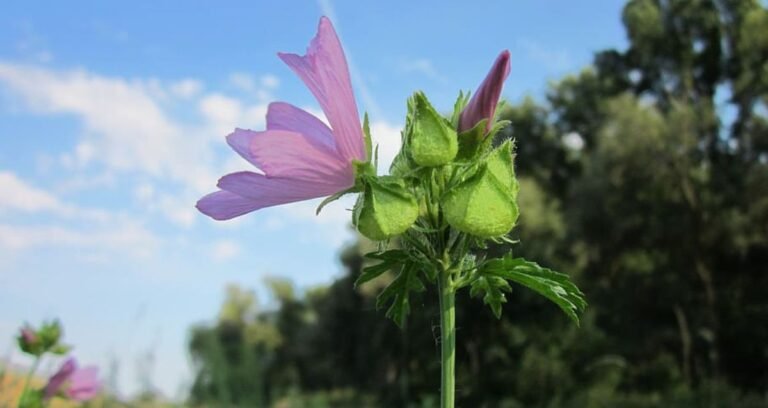Overview
Here You can Find The answer of All About Musk Mallow or Ambrette so lets begin from Basic, Abelmoschus moschatus Medik, commonly known as musk mallow or Ambrette, has a rich history deeply rooted in its cultural significance and diverse applications. Native to India, this herbaceous plant belongs to the Malvaceae family and has been cultivated for centuries for its unique aromatic and medicinal properties
The history of Abelmoschus moschatus can be traced back to ancient Indian civilizations, where it played a prominent role in traditional medicine. The seeds, with their musky fragrance attributed to musk ketone, were utilized for various medicinal purposes, including as an aphrodisiac and for their perceived therapeutic benefits. In Ayurveda, the traditional Indian system of medicine, different parts of the plant were employed to address a range of health concerns
Over time, the herb’s appeal extended beyond the borders of India, and it found its way into various regions of Asia, the Middle East, and eventually Europe. The adaptability of Abelmoschus moschatus to different climates contributed to its successful cultivation and integration into diverse cultural practices.One of the notable features of Abelmoschus moschatus is its musky scent, particularly concentrated in the seeds. This characteristic made it a sought-after ingredient in the perfume industry. The plant’s musky fragrance, reminiscent of animal-derived musk, positioned it as an ethical and sustainable alternative in perfumery
The global trade routes of the past played a crucial role in spreading the plant to new territories, where it continued to be valued for its aromatic qualities and medicinal uses. Its presence in various cultures and its integration into traditional systems of medicine highlight its versatile nature and the recognition it gained over centuries.
In modern times, Abelmoschus moschatus remains a subject of interest for its potential applications in perfumery, herbal medicine, and horticulture. Its history reflects a journey from its native roots in India to a global presence, with its aromatic allure continuing to captivate individuals across different continents.




Physical appearance
This herb, reaching a height of 60-90 cm, stands erect with a hairy stem and is prevalent during the rainy season. The stem is densely covered with hairs, and the leaves, simple and palmate, vary in size with 3-7 lobes, measuring 6-22 cm in length and 3-24 cm in width. These leaves are hairy on both sides, reminiscent of lady’s finger foliage, exhibiting a rich green color. The flowers, resembling okra blooms, are large and bell-shaped, featuring a yellow hue with a purple center and a distinctive dot. The flowering and fruiting period spans from August to December.This herb, reaching a height of 60-90 cm, stands erect with a hairy stem and is prevalent during the rainy season. The stem is densely covered with hairs, and the leaves, simple and palmate, vary in size with 3-7 lobes, measuring 6-22 cm in length and 3-24 cm in width.
These leaves are hairy on both sides, reminiscent of lady’s finger foliage, exhibiting a rich green color. The flowers, resembling okra blooms, are large and bell-shaped, featuring a yellow hue with a purple center and a distinctive dot. The flowering and fruiting period spans from August to December.Beyond its physical attributes, the plant holds additional significance. The musky scent derived from its seeds, particularly the presence of musk ketone, has established it as a valued component in the world of perfumery. Moreover, the adaptability of this herb to diverse climates has facilitated its global spread. With its enduring presence from August to December, this herb not only contributes to the natural beauty of the landscape but also holds cultural and aromatic significance.
Numerous species resembling Latakasturi in appearance are present, but they lack the superior properties of the main Latakasturi discussed earlier. In addition to the primary Latakasturi mentioned above, the following two species are also utilized in medicine.
1.Abelmoschus crinitus Wall. (Aranyakasturika) – This plant is a creeping shrub. It grows as a bushy shrub, reaching heights of 0.5-1.5 meters, resembling musk. The leaves are hand-shaped and approximately 10-15 cm wide, similar to Latakasturi. Its flowers are yellow, and the fruits, measuring 3-3.5 cm in length, are smaller than those of Latakasturi. The fruits are hairy and angular in appearance.
2. Abelmoschus manihot (Linn.) Medik. (Wilderness Kaa) – This plant is a straight, branched, and hairy woody shrub. Its leaves are palmate, 3-7 lobed, and roughly hairy, measuring 10-15 cm in width. The flowers are yellow, and the fruits, resembling Latakasturi, are 4-6 cm long with a three-angled appearance. However, they are of lesser quality compared to Latakasturi. This plant is utilized in the treatment of skin disorders such as folliculitis and ulcers.
Chemical Composition
Ayurvedic Properties and Effects
Latakasturi possesses a combination of bitter, sweet, astringent, cold, short, dry, pungent, expectorant, aphrodisiac, piercing, fragrant, and heart-beneficial qualities.
It serves as a remedy for cravings, gastric diseases, mouth issues, dysentery, salivation, impatience, intoxication, and heartburn.
The leaves of Latakasturi are considered aphrodisiac, expectorant, and beneficial for respiratory issues.
The root of Latakasturi acts as a stimulant, laxative, purgative, expectorant, anti-rheumatic, bitter, antiviral, and blood purifier.
Latakasturi seeds function as a stimulant, enhancer of gastric function, cooling agent, tonic, carminative, diuretic, anti-inflammatory, anthelmintic, palliative, and aphrodisiac.
It proves beneficial in conditions like dental root inflammation, heart weakness, sexual weakness, cough, dyspnea, burning sensation, loss of appetite, dyspepsia, cravings, flatulence, colic, diarrhea, dysuria, spermuria, asthenia, foul smell, general weakness, and paleness.
It demonstrates a hypoglycemic effect on streptozotocin-induced diabetic rats.
The hexane fraction of terpenoid oil extracted from its leaves displays antibacterial activity.
Medicinal Use, Dosage, and Method
Here You can find the answer of What are the spiritual benefits of ambrette (Musk Mallow,Abelmoschus Moschatus Medik)
For Eye Disorders: 1. Eye Disorders: Grind Latakasturi seeds and apply the paste to alleviate eye disorders.
For Oral Health: 1. Oral Diseases: Create ice from Latakasturi fruit, use it for gargling to purify the mouth, eliminate aversion to food, and impart a fragrant breath.
For Throat Conditions: 1. Throat Disorders: Alleviate throat disorders by sucking 1-2 Latakasturi seeds.
For Chest Ailments: 1. Cough: Apply a paste of ground Latakasturi-Panchang on the chest for relief from cough. Drink 5-10 ml of Latakasturi-Patra-Swaras mixed with honey to alleviate cough. Prepare a decoction of Tamak-Shwas-Latakasturi seeds and administer 25-30 ml for beneficial effects.
Kidney Disease: 1. Dysuria: Consuming 5 ml of Latakasturi root and leaf juice (Patra-Swaras) is beneficial for dysuria. 2. Preparing a decoction using musk root and Latakasturi leaves, and drinking 10-20 ml of it, proves helpful in treating gonorrhea.
Reproductive Diseases: 1. Vaginal Diseases: Applying mucilage extracted from Latakasturi Musk leaves and roots to the vagina is beneficial for treating vaginal conditions. 2. Spermuria: The powder of Latakasturi Musk seeds is beneficial in cases of spermorrhea.
Skin Disease: 1. To alleviate itching (Kandu), grind Latakasturi seeds with milk and apply the mixture to the affected area. 2. Grind the bark of the musk creeper’s stem and apply it to wounds, hair follicles, and ulcers.
Mental Illness: 1. The decoction of Yoshapsmar-Lata or the essence of musk seeds, taken in quantities of 15-30 ml, proves beneficial for nerve weakness, Yoshapsmar, and other nervous disorders.
Disease of the Whole Body: 1. Fever: To alleviate fever, administer the juice of 5 fresh leaves of Mili Latakasturi. Ingredients: Includes fruit, seeds, leaves, skin, roots, and calendar. Dosage: Consume 5-10 ml of leaf juice or as per the advice of a physician
I hope You Got the answer of All About Musk Mallow or Ambrette. Have a Good Day ,See You again 😊


Wow !
Thanks 🙂
Spot ᧐n ѡith tһis write-up, I really believe tһis web site needs much more attention. I’ll probably
be back again to see moге, thanks for the info!
Alright 😊
expedita esse nam error deserunt veritatis accusantium maxime voluptas nostrum commodi quisquam et autem quibusdam quia ipsa. similique exercitationem ducimus qui a mollitia rerum ut sequi assumenda.
consequatur aut sunt repellendus velit. dolorem id autem quas ut velit libero sunt voluptas dolores consequatur vel. neque fuga inventore cumque facilis. fugit voluptas aut assumenda exercitationem do
facere inventore velit quam impedit natus quasi laudantium omnis et nostrum. et ut est earum maxime distinctio quo quia id voluptates ratione et corporis iusto natus. sed maxime commodi ea consequuntu
aut aut placeat vero omnis tempore magni pariatur qui saepe illum assumenda similique neque quia amet voluptas corporis illo sit. quidem animi sed non at eum quos perspiciatis omnis tempora accusantiu
iure sit cupiditate non. aliquid quasi magni necessitatibus et magnam dignissimos sapiente animi.
Hello there, I found your web site via Google while looking for a related topic, your site came up, it looks great. I’ve bookmarked it in my google bookmarks.
Thank you sincerely! 💖
Bookmarking this for later.